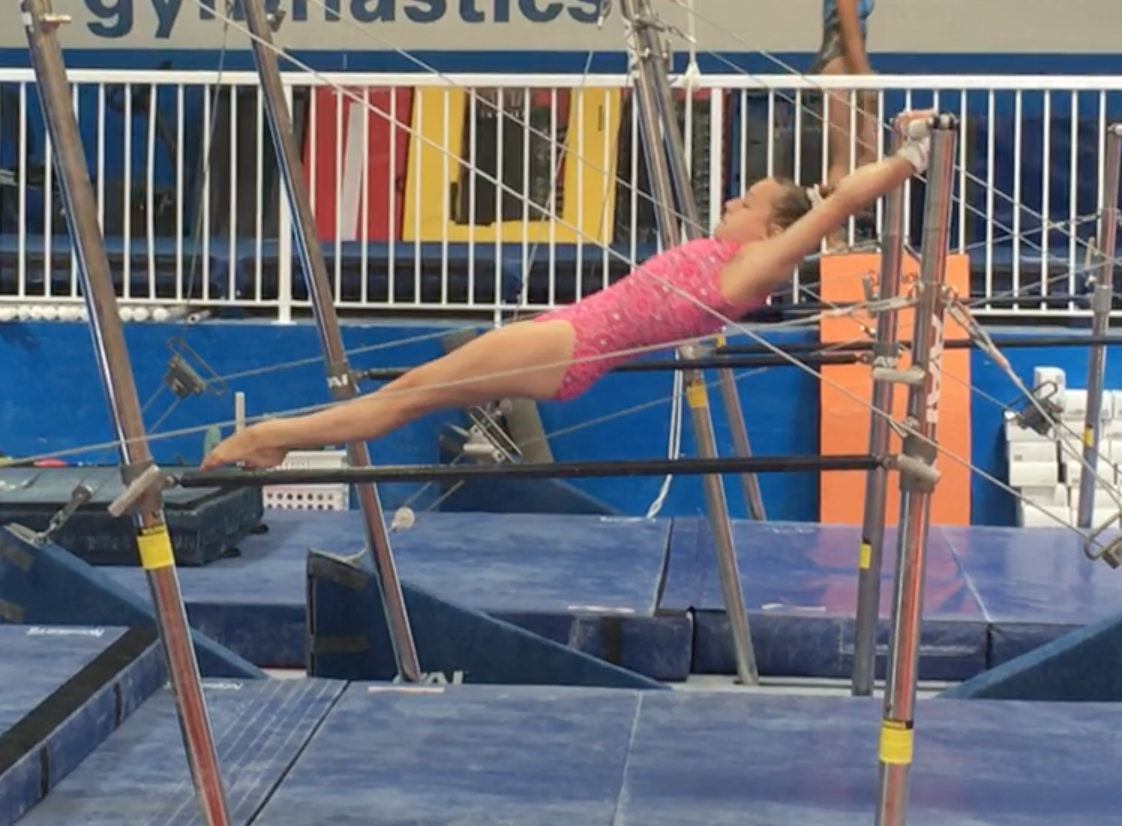
The glide kip on women’s uneven bars is #1 of the 4 basics to bars. (Learn more about the 4 Basics to Successful Uneven Bars) Actually, the glide kip alone is really only half of the first basic to bars. We consider the first basic of uneven bars to be the glide kip cast handstand. We always stay with working glide kip drills.
Glide Kip Drills with focus on extension.
This list of kip drills is for team athletes that already have their glide kips – advanced athletes who are working on improvement of shapes and strength, or skill maintenance by using the sequences or complexes.
Glide Extension – Basic Version
The glide extension should start with a hollow jump shape to the bar: a long powerful glide extension trying to get the hips and feet to rise parallel with the bar sliders. Do not allow the hips to open with the feet dropping which would cause an arch at the end of the glide putting unneeded pressure on the athlete’s lumbar spine. Also, this is the incorrect glide path for the feet to come towards the bar. The extension should have flat hips with a hollow chest with neutral head position throughout. The back swing should maintain a round lower back and have no arching (pelvic tilt).
Glide Extension – Advanced Version
Once your athletes are strong enough to perform the basic version of the glide extension they can move onto the advanced version. The advanced glide extension is not necessary for your athletes. However, we do this 1x a week to help develop quick strength along with the tap of the double layout bar dismount. Since this drill helps athletes understand the “late” tap of the double layout we use this in USA Gymnastics level 8 or 9 on up.
Glide Kip Extension Sequence #1
This is a great glide kip extension sequence to help build kip strength. We continue this glide kip sequence throughout our program. We use this at minimum 1x a week with advanced athletes to help build and maintain glide kip extension importance and shape strength.
Example of glide kip extension sequence #1
Here is an example of how we use this sequence within our uneven bar practice.
USA Level 7 through level 10 assignment example: 10 minutes to land 3 competition dismounts (1 step or less) MUST hit cast handstand on the high bar with this glide kip extension sequence 1. as the mount. Instead of putting their feet down at the end of the sequence they continue into a kip squat on to the high bar. Of course, you should not expect your athletes to jump into this type of workout if they do not have the foundation and abilities to successfully finish their assignments.
Glide Kip Extension Sequence #2
I first saw this sequence rotating with another team at a USAG elite development camp 6+ years ago and immediately implemented it into our program. This sequence covers the glide extension, the kip shaping with cast handstand, along with back giant taps swings, and a back layout (3 of 4 basics isn’t bad). Like glide extension sequence 1, this glide kip sequence works great into the 2nd half of the routine or into dismount once your athletes have the strength and endurance for this type of workout.
Other Glide Kip Drills
There are dozens of kip drills that address the pulling portion of the kip (upstart action) and the compressed finished position. These kip drills are combined into other posts for the kip and cast handstand drills.
Other events from How To Gymnastics:
Warning: The reader of this article should exercise all precautions before following any of the exercises from this article and website. To avoid any problems while doing the exercises, it is advised that you consult a medical professional and are supervised by a gymnastics professional. The responsibility lies solely with the reader and not with the site or the writers. This post can may contain affiliate links meaning if you buy something we get a small commission at no extra cost to you.